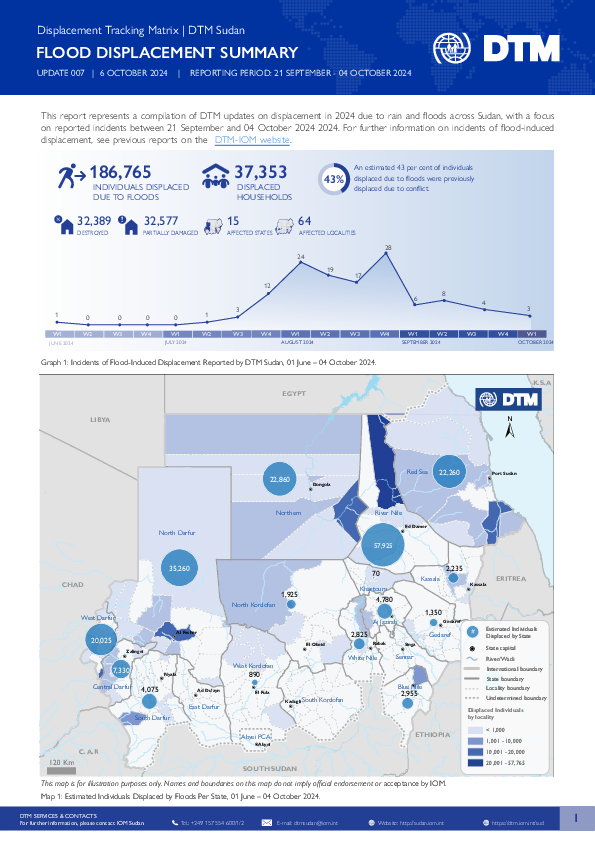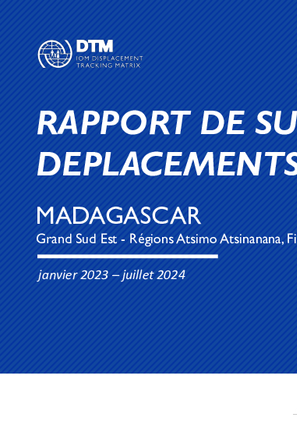-
Countries
-
Data and Analysis
-
Special Focus
-
Crisis Responses
Mobility Tracking
Contact
dtmdrc@iom.int
Location
Democratic Republic of the Congo
Activity
- Mobility Tracking
- Baseline Assessment
Period Covered
Jul 08 2024 -Aug 16 2024
Ce tableau de bord présente les principaux résultats de suivi des mouvements de populations dans la province du Sud-Kivu à l’issue du treizième round d’évaluation conduit par l’unité de la Matrice de Suivi des Déplacements (Displacement Tracking Matrix, en anglais (DTM)) de l’Organisation Internationale pour les Migrations (OIM). Ces évaluations ont été réalisées à travers un exercice de collecte de données conduit du 8 juillet au 16 août 2024, en collaboration avec l’ONG locale, Réseau d’Action pour le Développement et le Progrès Intégré (RADPI) et la Division Provinciale des Affaires Humanitaires (DIVAH). Lors de ce cycle, un total de 5 734 villages, couvrant 34 zones de santé (ZS), ont été évalués à travers des consultations avec 17 435 informateurs clé.
Population Groups
IDPs
Returnee (Previously Internally Displaced)
Survey Methodology
Unit of Analysis Or Observation
Admin Area 4
Type of Survey or Assessment
Key Informant
Keywords
Geographical Scope Partial Coverage
Administrative boundaries with available data
The current dataset covers the following administrative boundaries
Contact
DTM Yemen, iomyemendtm@iom.int
Location
Yemen
Activity
- Mobility Tracking
- Event Tracking
Period Covered
Sep 29 2024 -Oct 05 2024
From 1 January to 5 October 2024, IOM Yemen DTM tracked 2,819 households (HH) (16,914 Individuals) who experienced displacement at least once.
Between 29 September and 5 October 2024, IOM Yemen DTM tracked 24 households (144 individuals) displaced at least once. The majority of people moved into/within the following governorates and districts:
- Ma’rib (15 HH) – Ma’rib City (13 HHs), Ma’rib (2 HHs) districts. Most displacements in the governorate originated from Al Hodeidah and Sanaa.
- Ta’iz (5 HHs) – Al Maafer (3 HHs), Al Misrakh (1 HH), Salah (1 HH) districts. Most displacements in the governorate were internal.
- Al Hodeidah (4 HHs) – Hays (4 HHs) district. All displacements in the governorate were internal.
The majority of people moved from the following governorates and districts:
- Al Hodeidah (9 HHs) – Hays (4 HHs), Bayt Al Faqih (2 HH), As Salif (1 HH) districts.
- Ta’iz (6 HHs) – Maqbanah (3 HHs), At Taiziyah (1 HH), Salah (1 HH) districts.
- Sanaa (2 HHs) – At Tyal (2 HHs) district.
Population Groups
IDPs
Returnee (Previously Internally Displaced)
Survey Methodology
Unit of Analysis Or Observation
Admin Area 2
Type of Survey or Assessment
Household
Key Informant
Keywords
Geographical Scope Partial Coverage
Administrative boundaries with available data
The current dataset covers the following administrative boundaries

Contact
DTM Yemen, iomyemendtm@iom.int
Language
English
Location
Yemen
Period Covered
Sep 29 2024
Oct 05 2024
Activity
- Mobility Tracking
- Event Tracking
IOM Yemen DTM's Rapid Displacement Tracking (RDT) tool collects data on estimated numbers of households forced to flee on a daily basis from their locations of origin or displacement, allowing for regular reporting of new displacements in terms of estimated numbers, geography, and needs. It also tracks returnees who returned to their location of origin.
From 1 January to 5 October 2024, IOM Yemen DTM tracked 2,819 households (HH) (16,914 Individuals) who experienced displacement at least once.
Between 29 September and 5 October 2024, IOM Yemen DTM tracked 24 households (144 individuals) displaced at least once. The majority of people moved into/within the following governorates and districts:
- Ma'rib (15 HH) – Ma'rib City (13 HHs), Ma'rib (2 HHs) districts. Most displacements in the governorate originated from Al Hodeidah and Sanaa.
- Taiz (5 HHs) – Al Maafer (3 HHs), Al Misrakh (1 HH), Salah (1 HH) districts. Most displacements in the governorate were internal.
- Al Hodeidah (4 HHs) – Hays (4 HHs) district. All displacements in the governorate were internal.
The majority of people moved from the following governorates and districts:
- Al Hodeidah (9 HHs) – Hays (4 HHs), Bayt Al Faqih (2 HH), As Salif (1 HH) districts.
- Ta'iz (6 HHs) – Maqbanah (3 HHs), At Taiziyah (1 HH), Salah (1 HH) districts.
- Sanaa (2 HHs) – At Tyal (2 HHs) district.
IOM identified 70 additional households displaced in the previous reporting period, which covered 22 - 28 September 2024, in the governorates of Lahj (38 HHs), Al Hodeidah (24 HHs), and Ma'rib (8 HHs). These figures have been added to the cumulative displacement total recorded since the beginning of the year.

Contact
DTM Yemen, iomyemendtm@iom.int
Language
English
Location
Yemen
Period Covered
Jan 01 2024
Jun 30 2024
Activity
- Mobility Tracking
- Baseline Assessment
Between January and June 2024, DTM tracked a total of 1,648 instances of household displacements across the country. Please note that this can include multiple displacement meaning that these are not necessarily 1,648 distinct households. This period witnessed varied trends in displacement, with numbers peaking in January and gradually declining through June with a peak in May. The decrease in displacement figures later in the period might reflect temporary lulls in conflict or seasonal factors, but it also raises concerns about underreported cases in more remote or inaccessible areas.
Ma’rib, Al Hodeidah, and Ta’iz emerged as the most affected governorates, with Marib alone accounting for 770 displaced households. The ongoing conflict in these regions, coupled with economic deterioration, has exacerbated the situation, forcing families to abandon their homes in search of safety. The relatively higher displacement in these areas can be attributed to their strategic significance in the ongoing conflict, making these hotspots of military activity and civilian casualties.

Contact
DTM Sudan; dtmsudan@iom.int
Language
English
Location
Sudan
Period Covered
Sep 21 2024
Oct 04 2024
Activity
- Mobility Tracking
- Event Tracking
The Flood Displacement Summary summarizes DTM updates on incidents of flood-induced displacement across Sudan.
Between 01 June and 04 October 2024, DTM Sudan reported 126 incidents of heavy rains and floods that triggered sudden displacement in Sudan. Rains and floods have displaced an estimated 186,765 individuals (37,353 households) from locations across 15 different states across Sudan.
This report outlines incidents of flood-induced displacement between 21 September and 04 October 2024. Information on earlier reported incidents is available on the DTM Sudan website.
Highlights
- DTM observed three incidents of flood-induced displacement between 21 September and 04 October 2024.
- These reported incidents triggered the displacement of an estimated 5,930 individuals (1,186 households).
- Approximately 4,040 structures were either partially damaged or destroyed by the rain and floods.
- An estimated 43 per cent of individuals displaced due to floods were already displaced due to conflict.

Contact
dtmhaiti@iom.int
Language
English
Location
Haiti
Period Covered
Oct 03 2024
Oct 04 2024
Activity
- Mobility Tracking
- Event Tracking
This information was gathered following attacks that occurred in the commune of Saint Marc, specifically in the 5th communal section of Bocozelle, on 3rd of October 2024. A total of 6,270 individuals (1,281 households) were displaced as a result of these attacks. These individuals sought refuge in the communes of La Chapelle, Montrouis, Petite Rivière de l'Artibonite, and Saint-Marc, with 88% of them staying with relatives as host families, while 12% found refuge in three separate sites. At the time of drafting this report, the displacements were still ongoing. Updates will be disseminated by DTM IOM based on observations of new movements.
Contact
DTMDRC@iom.int
Location
Democratic Republic of the Congo
Activity
- Mobility Tracking
- Baseline Assessment
Period Covered
Jul 11 2024 -Aug 09 2024
The total number of internally displaced persons (IDPs) in the province is estimated at 322,302, approximately 9 percent of the total population of Tanganyika. This represents a 2 percent decrease compared to the 330,148 displaced persons recorded during the last data collection period conducted between April and May 2024 (Round 7). Additionally, there are 29,015 IDPs (9%) in the 15 sites covered by the CCCM mechanism and 24,138 displaced persons (7%) living in the 7 sites not covered by the CCCM mechanism. During this twelfth assessment cycle, covering the months of July and August 2024, DTM assessments recorded 269,149 internally displaced persons (IDPs) residing with host families (84% of the total, of which 200,452 were displaced in the past 24 months).
Population Groups
Survey Methodology
Unit of Analysis Or Observation
Site or Location
Type of Survey or Assessment
Key Informant
Keywords
Geographical Scope Partial Coverage
Administrative boundaries with available data
The current dataset covers the following administrative boundaries

Contact
DTM Nigeria, iomnigeriadtm@iom.int
Language
English
Location
Nigeria
Period Covered
Sep 23 2024
Sep 29 2024
Activity
- Mobility Tracking
- Event Tracking
Between 23 and 29 September 2024, a total of 1,253 new arrivals were recorded at locations in Adamawa and Borno states.
ETT assessments identified the following movement triggers: flood (397 individuals or 32%), seasonal farming (216 individuals or 17%), improved security (131 individuals or 10%), government re-integration (124 individuals or 10%), poor living conditions (122 individuals or 10%), attacks (96 individuals or 8%), military operation (81 individuals or 6%), family re-unification (41 individuals or 3%), fear of attack (22 individuals or 2%), communal clashes (19 individuals or 2%) and access to humanitarian support (4 individual or less than 1%).

Contact
DTM Madagascar, DTMMadagascar@iom.int
Language
English
Location
Madagascar
Period Covered
Jan 01 2023
Jul 31 2024
Activity
- Mobility Tracking
- Baseline Assessment
La côte Est de Madagascar a été frappée en février 2022 par deux cyclones (Bastirai et Emnati) provoquant le déplacement de milliers de personnes qui ont trouvé refuge dans des sites temporaires et spontanés ou auprès des familles et proches. Dans deux régions (Vatovavy et Fitovinany) près de 141,800 personnes ont vu leurs maisons détruites. Une évaluation rapide par l’organisation internationale pour les migrations (OIM) et le Programme Alimentaire Mondial (PAM) en avril 2022 indique que 30 % des ménages dont les maisons ont été détruites vivent toujours dans des familles d'accueil auprès des communautés d’accueil, et 25 % des ménages ont déclaré qu'un ou plusieurs membres de leur famille ont déménagé.
Le projet SOREBE (Soutien au Relèvement Précoce) est financé par le Japon pour la période de janvier 2023 à janvier 2024. Les objectifs principaux du projet sont de collecter des données sur les déplacements et les impacts sur les communautés, fournir un appui aux activités génératrices de revenus, et contribuer au renforcement des capacités des personnes déplacées et des communautés d'accueil et des partenaires, en particulier les femmes, les hommes et, le cas échéant, les ménages les plus vulnérables des communautés d'accueil.
Le déploiement de la Matrice de suivi des déplacements (Displacement Tracking Matrix – DTM) par l’OIM dans le cadre de ce projet vise à ce que les partenaires gouvernementaux et les agences humanitaires ont accès à des informations actualisées et précises sur les besoins des déplacés internes et des communautés d'accueil dans les communes et fokontany évalués.
Les résultats présentés ci-dessous sont le fruit des évaluations menées en juin 2023 dans 15 communes : Vatovavy (Mananjary, Tsiatosika, Tsarahafatra, Nosy Varika, Soavina), Fitovinany (Manakara, Sahasinaka, Vohimasina Sud, Ambohimisafy, Andefapony), Atsimo Atsinanana (Farafangana, Tangainiony, Vangaindrano, Befotaka, Nosifeno).

Contact
dtmlebanon@iom.int
Language
English
Location
Lebanon
Period Covered
Oct 10 2023
Oct 02 2024
Activity
- Mobility Tracking
- Baseline Assessment
Since October 8 there has been an increase in cross-border incidents between Israel and Lebanon, resulting in the displacement of people both within the South and elsewhere within the country. Since October 10, the Displacement Tracking Matrix (DTM) has been conducting the daily monitoring of population movements. The objective of the exercise is to inform preparedness and response planning.
Pagination
- Previous page
- Page 19
- Next page
